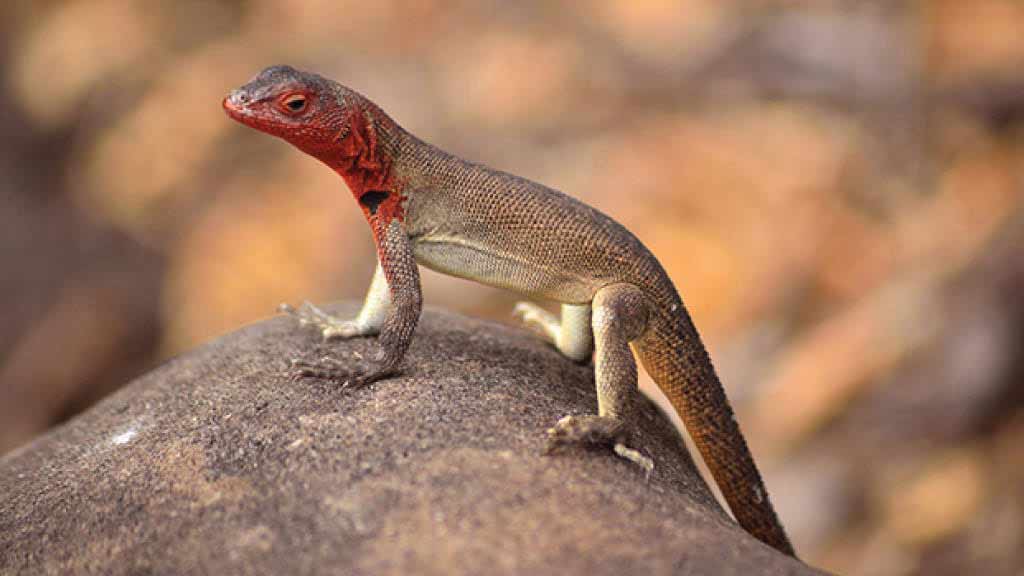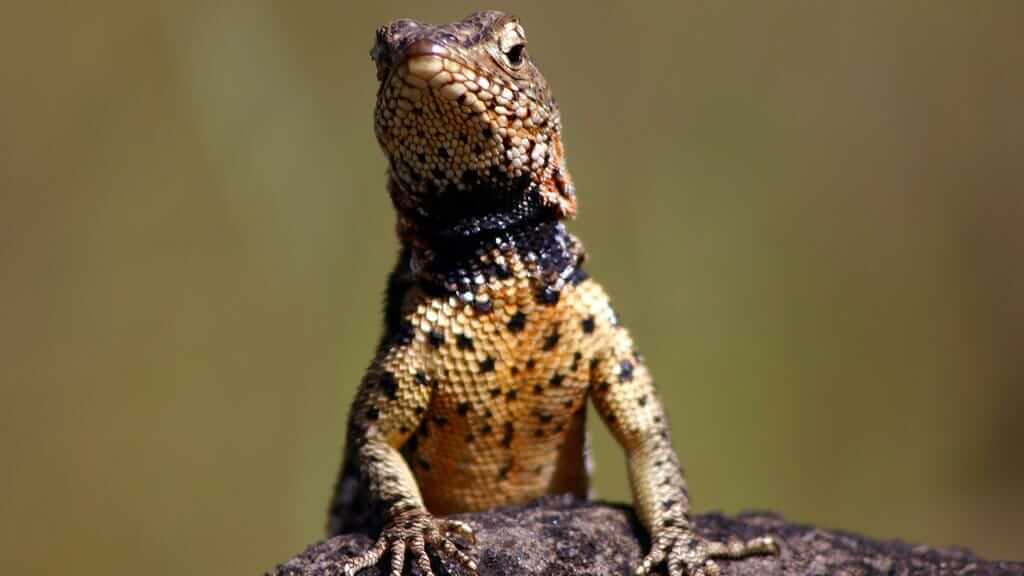GALAPAGOS LAVA LIZARD
The Galapagos Lava Lizard is the most frequently sighted reptile on the Galapagos Islands. They are found right across the archipelago and visitors rarely need to look very hard to spot them. Perhaps due to this fact and their diminutive size, they are an often Galapagos overlooked species. But for those who take a little time to get to know them, the Galapagos Lava Lizard can be rather fascinating.
For starters, Lava Lizards in Galapagos don bright colorings that are wonderfully photogenic. Galapagos Lava Lizards are also rarely shy, so photographers can crouch down close to them to capture great detail.
The Galapagos Lava lizard also has some incredibly unique abilities and behaviors to observe, like performing push-ups and shedding their tails. So give these little fellas a chance, and let's get to know them better.
Read on for everything you ever wanted to know about the Galapagos Lava Lizard. Where and When to spot them? How to recognize them? And why on earth do lava lizards do push-ups?
The Galapagos Lava Lizard is an: ENDEMIC SPECIES
Conservation Status: Near Threatened
Scientific Name: Microlophus spp. (7 different subspecies)
How To Spot A Galapagos Lava Lizard?
This one's easy! If anything, Galapagos Lava Lizards are impossible not to spot! In the common arid scrubland habitat, they seem to perch on every rock or be scurrying from one place to another.
There are in fact 7 different Galapagos Lava Lizard species from the genus Microlophus. So let's find out where to look for them.
Where to Spot Galapagos Lava Lizards?
Lava lizards inhabit all Galapagos islands with the exception of Genovesa, Darwin, and Wolf. The most common Galapagos Lava Lizard species is found on 10 of the central & western islands. While the other 6 species each live on one specific island (Española, Floreana, Marchena, Pinta, Pinzon & San Cristobal). All of these lava lizard species are endemic to the Galapagos and are believed to have evolved from one common mainland South American ancestor.
When to See Lava Lizards in the Galapagos?
Galapagos Lava Lizards are easy to spot all year round. They are generally most active during the day when the sun is out.
Contact us for a FREE GALAPAGOS TOUR QUOTE, or for more information about how to plan your vacation to the Galapagos Islands. Happy Gringo have been one of the leading Galapagos Islands Agents since 2004, helping over 10k happy tourists to realize their dream vacation. We also come highly recommended on both Trip Advisor and Trust Pilot.
Everything You Ever Wanted To Know About Galapagos Islands Lava Lizards
How to Recognize a Galapagos Lava Lizard?
Galapagos Lava Lizards have similar appearances across each of their seven subspecies. They are small and slim, averaging 5-6 inches long. Individuals vary in color from grey to green or brown and even black. Males tend to be larger in size, up to 2 or 3 times that of a female. Males also have brighter colors with yellow specks or gold stripes, and a spiny back crest. Females are easy to recognize with an attractive red throat or head.
Amongst other Galapagos lizard species, it's also easy to tell them apart from Land Iguanas and Marina Iguanas. Lava lizards are significantly smaller in size and different in color.
Galapagos Lava Lizard Behavior
Lava Lizard breeding season takes place in the warm months at the start of the year. A large male will typically control a territory as large as 400 square meters, and attempt to mate with any female that passes through. The competition for Galapagos Lava Lizard territories often becomes competitive, with aggressive consequences. This leads to a very common question: Why do lava lizards do pushups?
A male Galapagos Lava Lizard is very protective of his territory, knowing that other males are more than happy to encroach. Each lava lizard male needs to vigorously defend their ground, and show the others who is boss. What better way to convince others not to mess with you than a macho show of testosterone? To do this the defending male launches into an intimidating round of frantic push-ups. If he is able to make himself look big and strong then the intruder may give up and move on elsewhere. But if he is unimpressed then the tension escalates into a full-on push-up contest. It's pretty exhausting stuff under the hot tropical sun, but the potential reward of females to romance spurs them both on. What happens if the press-up competition ends in a draw? Conflict becomes inevitable with tail slapping and biting to determine the victor.
If the victorious male has any energy left after his epic muscle gym session, then he can enjoy his spoils. He may attempt to mate with any female within his territory. Females lay small pea-sized eggs, four to six at a time, buried deep in the soil. After three months of incubation, the eggs hatch into tiny little Galapagos lava lizard babies.
Lava Lizard Galapagos Habitat
Lava Lizards prefer the lowlands and shorelines of the Galapagos. They look for dry sandy areas, with rocky nooks and crannies to hide under. They also need to be close to cacti and vegetation to attract bugs for them to feed on.
As cold-blooded creatures, they need sun rays to stay warm and are often spotted sunbathing atop lava rocks. But on extremely hot days they'll retire to shadier spots to conserve their energy.
Galapagos Lava Lizard Diet
Not surprisingly, Lava Lizards love to eat bugs. Their diet consists mostly of flies, ants, moths, grasshoppers, beetles, centipedes, and spiders. Interestingly, they can also adapt to eat seeds and plants if necessary. This is a particularly handy adaptation during times of drought when plants and insect populations are less abundant.
Fun Galapagos Lava Lizard Facts
• Galapagos Lava Lizards are capable of changing color and might have various reasons to do so. Firstly for camouflage, a lava lizard may adapt to blend in better with their surroundings if they spot a potential predator. They might also change based on mood or ambient temperature changes. Scientists believe that the range of color change may vary depending on which Galapagos island they inhabit.
• Being so small, the Galapagos Lava Lizard has a long list of predators who might want to eat them. Snakes and Galapagos hawks are their most fearsome predators, but lave lizards also need to be wary of Galapagos mockingbirds and herons. To counter these threats they have developed three very effective defensive mechanisms. Firstly, they rely on excellent color camouflage. Secondly, in the event that they have been spotted, Galapagos Lava Lizards are also very speedy at gaining safe ground in a crevasse or under a rock. Thirdly, and most remarkably, they can disconnect their tail from their body during a predator attack. Why would this be an appropriate tactic? Their tail continues to squirm on the ground to distract the would-be predator. Meanwhile, the lava lizard has a few valuable seconds to make a cunning escape. Happily, the lava lizard's tail grows back again in a matter of weeks.
• Lava Lizards play an important role in the Galapagos food chain. As their diet consists mostly of insects, they help us with pest control. This is especially true of the painted locust, which otherwise causes great damage to native flora and habitat.
If you enjoyed this post, then check out more information about Galapagos Islands Reptiles and Animals.
In conclusion, the Galapagos Lava Lizard is a charismatic little fella. Close-up photos of them can be spectacular, especially using a macro lens. Videos of their muscle-beach pushup antics are great value too! So don't rush on past in search of bigger or more exciting creatures. Share a precious moment with the humble Galapagos Lava Lizard, and you might just find yourself surprised.




